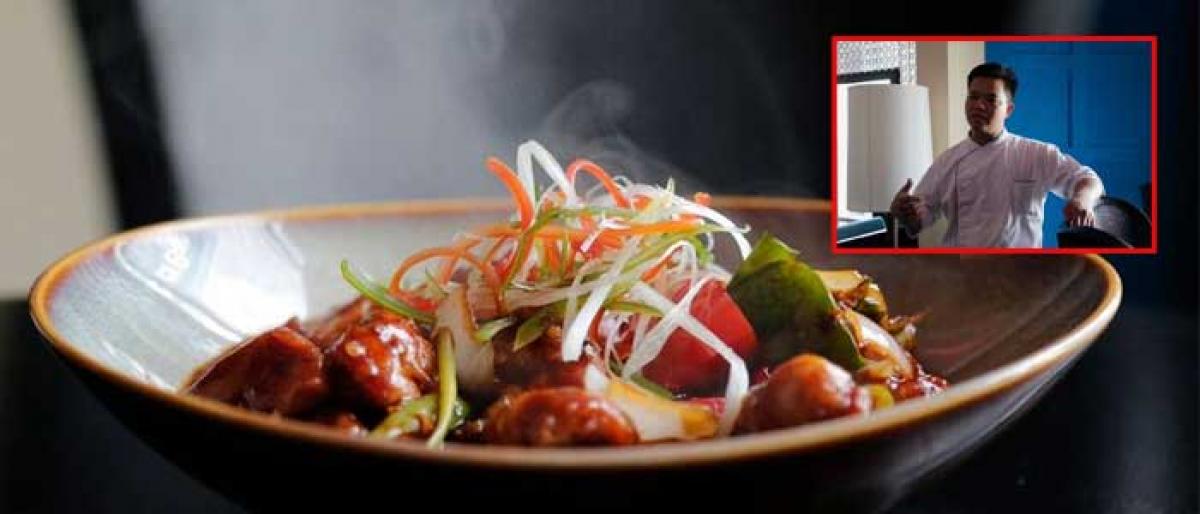Live
- Pakistan Protests: PTI Supporters March Towards Islamabad, Demanding Imran Khan's Release
- Additional Collector Conducts Surprise Visit to Boys' Hostel in Wanaparthy
- Punjab hikes maximum state-agreed price for sugarcane, highest in country
- Centre okays PAN 2.0 project worth Rs 1,435 crore to transform taxpayer registration
- Punjab minister opens development projects of Rs 120 crore in Ludhiana
- Cabinet approves Atal Innovation Mission 2.0 with Rs 2,750 crore outlay
- Centre okays Rs 3,689cr investment for 2 hydro electric projects in Arunachal
- IPL 2025 Auction: 13-year-old Vaibhav Suryavanshi becomes youngest player to be signed in tournament's history
- About 62 lakh foreign tourists arrived in India in 8 months this year: Govt
- IPL 2025 Auction: Gujarat bag Sherfane Rutherford for Rs 2.60 cr; Kolkata grab Manish Pandey for Rs 75 lakh
Just In

Noodles and Manchurian prepared using soya sauce and corn flour in generous portions is an all-India, all-time favourite food that for long was considered truly Chinese, until almost the beginning of the 21st century. As the exposure to authentic Chinese food increased, people began to realise that Manchurian is as Indian as it can get.
Hakka noodles, Chopsuey, Manchurian, use of fresh coriander and green chillies, fiery and hot, tangy and sweet flavours make for Tangra cuisine - the Indian Chinese that has travelled from Kolkata's China Town to the rest of India
Noodles and Manchurian prepared using soya sauce and corn flour in generous portions is an all-India, all-time favourite food that for long was considered truly Chinese, until almost the beginning of the 21st century. As the exposure to authentic Chinese food increased, people began to realise that Manchurian is as Indian as it can get.
In fact, there is every possibility that Manchurian – the vegetarian and meat balls deep fried and finished in a profusion of soya and chilli has originated in the famous China Town of Kolkata along with Hakka noodles, chicken drum sticks and other delicious preparations that are spicy, sour and sweet – the flavours that Indians love.
Calcutta, the capital of British India could be easily accessed from China and there has been immigration of Chinese, especially from Cantonese and Hakka regions. The people from Cantonese depended on food business, while those from Hakka region opened tanneries.
However, when Indian government banned tanneries the Hakka Chinese, who were settled in the Tangra region set up restaurants, which is now ‘The Destination’ for Chinese food in Kolkata. The restaurants have become so famous that they are featured on the to-do list for the tourists.
Chef Ho Chi Ming at the Asian restaurant Zega at Sheraton Hyderabad, who is from the region has conceptualised Tangra Food Festival and has brought alive China Town in city of Nizams.
He says, “Hakka people probably were more good at marketing. They opened their restaurants and tweaked the classics and created new dishes to appeal to the local palette. Since, Bengalis like their food to have a sweet tinge, you see the tangy and sweet ketchup used.
At homes, we use just a dash of soya whereas Indians like their noodles with a lot more of soya sauce. The consistency of the gravy of corn flour is thinner and food is more spicy in restaurants unlike Chinese’ homes. Use of fresh coriander in chicken wings and green chillies are some of the Indian touches making for the Tangra cuisine.”
Indian Chinese of Kolkata have long since adapted Indian ways.
But, there are a few habits that have stayed. They can never have a meal without meat involved and eat a lot of sauteed vegetables. The Chinese New Year celebrations surely will include a visit to the Achipur where there is a temple built for the man who was probably the first China man to have settled in the area as a mark of respect for the ancestors, on the altar of Buddha all kinds of dishes including pork, meat and whisky are offered in addition to the traditional Buddha Delight, made using baby corn, shitake, wood ear, carrot, asparagus, beans and water chestnuts.
In restaurants crunchy fried, steamed or sautéed in a combination of flavours – sweet, sour, hot and spicy using a plethora of ingredients soya, sesame, bean and Szechwan sauces, honey, sugar, jaggery, rice vinegar, dry chillies, pepper corns and green chillies –taken from both Chinese and Indian food – The Tangra cuisine has acquired the vibrancy and taste that is extremely addictive.
No wonder, the guests who are tasting the food at Zega are coming back for the likes of Chicken Winglet Chilli Garlic, Fish Butter Garlic and Chilli, Prawn Ball Hot Garlic Sauce, Honey Chilli Thai Lotus Stem, Hakka noodles and chopsuey. The fiery tastes and the flavours deliciously lace your palate.
For the spice-loving southerners, authentic Chinese with its subdued flavours will surely pale when compared to Tangra cuisine. After all we do love Chinese food, but more so the Indian way.

© 2024 Hyderabad Media House Limited/The Hans India. All rights reserved. Powered by hocalwire.com







